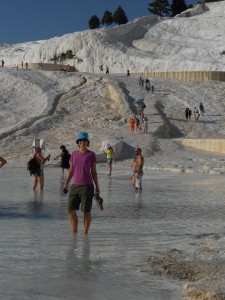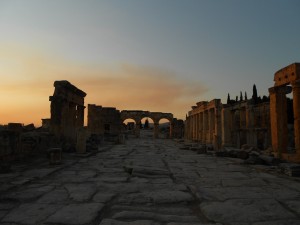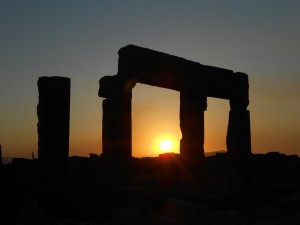On Wednesday, August 24, we caught a bus to a town named Pamukkale (Pah-muh-call-eh), a place known for its calcium-coated travertine pools and the ruins of ancient Hierapolis. The bus ride from Selcuk took about 2 1/2 hours as we traveled inland and through the mountains. The bus line ended about a 1/2 hour away from Pamukkale in a town named Denizli, where we crammed into a minibus, called a dolmus for the final leg of the journey.
The whole dolmus experience is pretty funny; you are rushed off of the bus escorted by the bus attendant, hastily turned over to the dolmus driver, who in turn thrusts you toward the dolmus and urgently heaves your bags into the trunk, and pushes you into the vehicle. After all this sprinting and panic, the dolmus driver proceeds to stand outside the vehicle smoking cigarettes until the process is repeated with at least a dozen or more likely two dozen more people, all while you sit in the the 100 degree dolmus wondering at what point you quit being the fish on the line and actively became the baking filet in the oven.
Along the way, the dolmus driver continues to pick up fares until he can barely shut the door, all while screaming incessantly into a walkie-talkie as he drives. As the heat swells with 20 bodies in a 12’X4′ space, one cringes with every cough or sneeze that promises to bring an oncoming plague to the entire bus. Needless to say, we were happy to step off the dolmus in Pamukkale.
Pamukkale is really small, so even though we were “on the other side of town” from the bus station, a five minute walk got us to the Hotel Dort Mevsim, which translates to “Four Seasons.” Although not fancy like its namesake, the hotel was a great value and run by a very nice family. It was really clean with comfortable beds, although the hot pink walls had me questioning a few things, and a wonderful swimming pool with the same water as the travertines. We hung out at the pool most of the afternoon until the heat went down enough for us to venture out to the monuments.
The travertines are striking; in the middle of a normal hillside mix of brown and green, this giant section of ghostly white protrudes from the cliffs. No matter how many times you remind yourself that you are standing in triple digit heat, you still look up and say to yourself, “hmmm, that’s a funny place for snow…”
From my understanding, the water in this area is super dense with calcium, and as it has spilled over the cliffs for many years, it has left huge deposits of hardened calcium on the ground. You can wade through this area, the water is supposed to be very healing to your body, and soak in man-made pools (the natural ones are mostly dried up, perhaps because of human development of the town) along the path that lead to the ruins of Hierapolis.
Walking up the travertines was spectacular! I immediately learned to walk along the hardened deposits whenever possible in order to avoid the sharp gravel in the puddles of warm water; the water ran soothingly over the cool calcium path and felt great on our roasting feet. I was unable to avoid mental images of petrified cauliflower, but at the same time the views across the travertines were breathtaking. Several times, we joined the many skimpily bikini and speedo-clad Europeans–joined in location but not in clothing choice–in wading into the pools; our only regret was that we had not dressed in our swimsuits because we had read that it was mostly dried up (the manmade pools must be fairly new), but we waded, and I couldn’t resist soaking for a minute or two in the chalky water anyway.
At the top of the path, we enjoyed some shade for a few minutes in yet another lovely Turkish park; it seems evident that our tourist money goes back into the monuments in this country. Feeling refreshed, we moved on to the ancient ruins of Hierapolis, which was founded around 190 BC as a spa city where people went in hopes of being healed. The city flourished under both Roman and Byzantine rule for centuries, finally falling (literally) victim to a series of devastating earthquakes somewhere aroung the 14th century, I think. If we had visited these ruins before Ephesus, I think we would have been more impressed, but it was still fun to explore this area.
Compared to Ephesus, the ruins are, well, much more ruined. Much more extensive work had been done in Ephesus, and I would guess that the earthquakes probably made piecing together Hierapolis even more difficult. Among the sites that stood out were the foundation of the Temple of Apollo (who along with Aphrodite were worshipped in the original city), with its three sizable columns remaining, the ruins of the Byzantine church, and the giant Arch of Domitian, with its two looming towers.
Believe it or not, the latrines were just as fascinating, if only because you could see where they had dug channels along the edges of the room where running water would “flush” the waste out of the latrine and under the streets! We even read that they had seats covering the channels.
Although we ran out of daylight before making it up the hill to explore the agora (which is basically a big open space now) and the theater (basically the same as two or three others we had seen elsewhere), we did enjoy a beautiful sunset over the travertines and across a broad expanse–the people of Hierapolis would have had a wonderful evening view!
The next morning’s dolmus ride eclipsed the previous one as our driver, who bore an amazing resemblance to Dan Akroyd’s classic Saturday Night Live “wild and crazy guy” character, spent a good half-hour trolling backroads teeming with cornstalks and gravel looking for an additional fare or two; I really expected him to pick up a chicken with three Turkish lira and a sign that said “please, take me to the market” attached to it’s coxcomb. Finally, the 20 passengers who had already paid convinced him to speed up the process, considering that most of us were about to miss our connecting busses so that he could make another $1.50. We spent the remainder of the ride clinging to our seats as he tore through the streets and into the bus station, honking and swerving while screaming into his cell phone the entire way!








Mike – you have a bright future as a blogger! You make the funniest jokes. I especially like the Dan Akroyd imagery. Thanks to both of you for sharing.